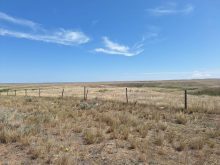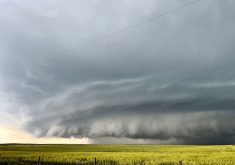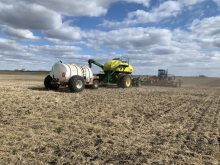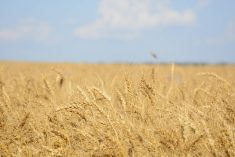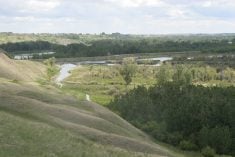The federal government has revised the application deadline for the cash advance program to accommodate farmers with unharvested crops, but for some growers it isn’t going to help.
The deadline for seeded advances was Aug. 31, 2016. After that date, farmers can get advances only for grain that is in the bin.
However, a lot of grain is still in the field this year because of unusually wet harvest conditions, so the federal government extended the seeded advance application deadline until March 31.
“It gives (farmers) the opportunity to get cash flow for grain that’s still in the field,” said Dave Gallant, director of finance and operations for the Canadian Canola Growers Association.
Read Also

Farming Smarter receives financial boost from Alberta government for potato research
Farming Smarter near Lethbridge got a boost to its research equipment, thanks to the Alberta government’s increase in funding for research associations.
There were three million unharvested acres in Saskatchewan as of Nov. 18, 2.1 million of which were insured.
Alberta had 2.58 million unharvested acres as of Nov. 15, of which two million were insured.
Manitoba had 626,000 insured acres in the field as of Nov. 2 but considerable progress has been made since then and very little is left in the field.
Growers need to have crop insurance to take out an advance. The amount of the advance is a complicated calculation based on acreage remaining to be harvested and the level of crop insurance on that crop.
Gallant said the canola growers association receives five to 10 phone calls a day from growers wanting to know what they can do to get an advance on their unharvested grain, so it was welcome news when Ottawa agreed to revise the deadline.
“We knew it was causing farmers a lot of stress,” he said.
“What we’re hearing from farmers is, ‘this is great news. At least we can get some cash now until we can get this off the field.’ ”
However, the deadline extension does not provide much of a lifeline for some farmers.
Charlie Boser, a grower from Luseland, Sask., said he doesn’t plan to use the program despite having 2,000 acres remaining in the swath.
He does not want to risk taking out an advance on crop that will likely be worth very little next spring because of deteriorating quality.
“I could very well end up with another bill on top of the bills I still have out there because of the quality thing,” he said. “Today we’re getting rain here like it’s the middle of June.”
Boser said he remembers what happened with 700 acres of oats that sat through last winter. When he was able to harvest the crop in the spring it was feed. Boser received $1.65 per bushel from a feed mill but half of that paid for cleaning expenses.
He believes the government should have also extended the repayment date on the 2016 cash advance program instead of leaving it at Sept. 30, 2017.
“The extension of the application, that’s fine and dandy, but if you don’t extend the deadline for repayment, you’re not doing anybody any favours,” said Boser.
“You’re going to have to spread out this repayment thing because there’s no way you can pay it all back with a crop that’s going to be worth maybe $2 or $3 (a bu.) instead of $5.”
Jeremy Welter, a farmer from Kerrobert, Sask., said Boser raises valid concerns.
Welter has 1,600 acres of canola and barley left in the field. He may take out an advance on the canola, but his barley is definitely feed quality and feed prices are low, so it won’t generate much of an advance.
He too worries about his ability to pay back any advance because of deteriorating yields and quality. The money may well have to come out of next year’s harvest.
“Which of course just ends up putting me further behind the eight ball,” said Welter.
However, he can see how the deadline extension could help some growers who have bills coming due and plenty of unharvested crops.
The government has also indicated it is considering increasing the $400,000 limit on the cash advance program, according to an Oct. 29 email from Patrick Girard, senior media relations officer with Agriculture Canada.
“The minister has asked departmental officials to review the current limits and assess the need for an increase,” he wrote.
Girard was asked if the federal government is still considering increasing the limit or if extending the application deadline was the extent of the government’s tinkering with the program. His response did not provide much clarity on that subject.
“Departmental officials are working very closely with the Advance Payment Program administrators on a daily basis to monitor the situation and to provide flexibility to producers who have not been able to fully harvest their crop,” he wrote in a Nov. 21 email.
The canola growers association wants Ottawa to double the limit to $800,000 because farms are bigger and crop inputs more expensive than when the limits were last revised a decade ago.
“Perhaps the change in government has changed the desire for looking at the limits,” said Gallant.
“I’m not sure why it has gained additional traction, but we are happy to hear that the minister is thinking about it and that he has talked to his staff.”







